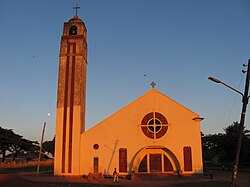Luena Luso | |
|---|---|
Municipality and town | |
| Coordinates: 11°47′30″S19°54′22″E / 11.7918°S 19.9062°E | |
| Country | |
| Province | Moxico Province |
| Area | |
| 42,300 km2 (16,300 sq mi) | |
| Population (2014 Census) [1] | |
| 357,413 | |
| • Density | 8.4/km2 (22/sq mi) |
| • Urban | 273,675 |
| Time zone | UTC+1 (WAT) |
| Climate | Cwa |
Luena, formerly known as Luso, is a city and municipality in eastern Angola, administrative capital of Moxico Province. The municipality had a population of 357,413 in 2014. [1]




